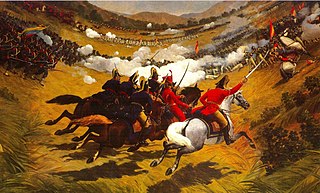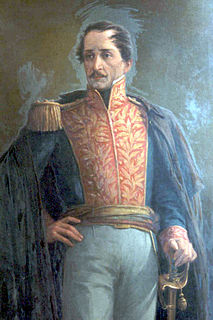This is a list of notable criollos . All people considered as criollos, i.e., people who are direct descendants of Spanish, having a reliable source that says, are in this list.
This is a list of notable criollos . All people considered as criollos, i.e., people who are direct descendants of Spanish, having a reliable source that says, are in this list.

Antonio José de Sucre y Alcalá, known as the "Gran Mariscal de Ayacucho", was a Venezuelan independence leader who served as President of Peru and as the 2nd President of Bolivia. Sucre was one of Simón Bolívar's closest friends, generals and statesmen.

Juan Emilio Bosch Gaviño was a Dominican politician, historian, writer, essayist, educator, and the first democratically-elected president of the Dominican Republic for a brief time in 1963. Previously, he had been the leader of the Dominican opposition in exile to the dictatorial regime of Rafael Trujillo for over 25 years. To this day, he is remembered as an honest politician and regarded as one of the most prominent writers in Dominican literature. He founded both the Dominican Revolutionary Party (PRD) in 1939 and the Dominican Liberation Party (PLD) in 1973.

The Bolivian war of independence began in 1809 with the establishment of government juntas in Sucre and La Paz, after the Chuquisaca Revolution and La Paz revolution. These Juntas were defeated shortly after, and the cities fell again under Spanish control. The May Revolution of 1810 ousted the viceroy in Buenos Aires, which established its own junta. Buenos Aires sent three large military expeditions to Upper Peru, headed by Juan José Castelli, Manuel Belgrano and José Rondeau, but the royalists ultimately prevailed over each one. However, the conflict grew into a guerrilla war, the War of the Republiquetas, preventing the royalists from strengthening their presence. After Simón Bolívar and Antonio José de Sucre defeated the royalists in northern South America, Sucre led a campaign that was to defeat the royalists in Charcas for good when the last royalist general, Pedro Antonio Olañeta, suffered death and defeat at the hands of his own defected forces at the battle of Tumusla. Bolivian independence was proclaimed on August 6 of 1825.

The military and political career of Simón Bolívar, which included both formal service in the armies of various revolutionary regimes and actions organized by himself or in collaboration with other exiled patriot leaders during the years from 1811 to 1830, was an important element in the success of the independence wars in South America. Given the unstable political climate during these years, Bolívar and other patriot leaders, such as Santiago Mariño, Manuel Piar, José Francisco Bermúdez and Francisco de Paula Santander often had to go into exile in the Caribbean or nearby areas of Spanish America that at the moment were controlled by those favoring independence, and from there, carry on the struggle. These wars resulted in the creation of several South American states out of the former Spanish colonies, the currently existing Venezuela, Colombia, Ecuador, Peru and Bolivia, and the now defunct Gran Colombia.

The Venezuelan War of Independence was one of the Spanish American wars of independence of the early nineteenth century, when independence movements in Latin America fought against rule by the Spanish Empire, emboldened by Spain's troubles in the Napoleonic Wars.

Bolívar's campaign to liberate New Granada was part of the Colombian and Venezuelan wars of independence and was one of the many military campaigns fought by Simón Bolívar. Bolívar's victory in New Granada secured the eventual independence of northern South America. It provided Bolívar with the economic and human resources to complete his victory over the Spanish in Venezuela and Colombia. Bolívar's attack on New Granada is considered one of the most daring in military history, compared by contemporaries and some historians to Napoleon's crossing of the Alps in 1800 and José San Martín's Crossing of the Andes in 1817.

Cúcuta, officially San José de Cúcuta, is a Colombian municipality, capital of the department of Norte de Santander and nucleus of the Metropolitan Area of Cúcuta. The city is located in the homonymous valley, at the foot of the Eastern Ranges of the Colombian Andes, on the border with Venezuela. It comprises an area of approximately 1119 km2, with an urban area of 64 km2 and a rural area of 1055 km2. The city has a population of 777,106 inhabitants, which makes it the most populous municipality in the department and the sixth most populous municipality in the country. Similarly, its metropolitan area has an approximate population of 1,046,347.

The Battle of Boyacá (1819), was the decisive battle that ensured the success of Bolívar's campaign to liberate New Granada. The battle of Boyaca is considered the beginning of the independence of the north of South America, and is considered important because it led to the victories of the battle of Carabobo in Venezuela, Pichincha in Ecuador, and Junín and Ayacucho in Peru.

Francisco José de Paula Santander y Omaña, was a Colombian military and political leader during the 1810–1819 independence war of the United Provinces of New Granada. He was the acting President of Gran Colombia between 1819 and 1826, and later elected by Congress as the President of the Republic of New Granada between 1832 and 1837. Santander came to be known as "The Man of the Laws".

The Palacio de Miraflores is the official residence of the President of Venezuela. It is located on Urdaneta Avenue, Libertador Bolivarian Municipality in Caracas.

The National Pantheon of Venezuela is a final resting place for national heroes. The Pantheon was created in the 1870s on the site of the ruined Santísima Trinidad church from 1744 on the northern edge of the old town of Caracas, Venezuela.

Domingo de Caycedo y Sanz de Santamaría was a Colombian statesman who served as the vice president of Gran Colombia and the Republic of New Granada. He served as President of Colombia a total of eleven times, the most terms any president has served to date. He is also credited for creating the Republic of New Granada after the division of Venezuela and Ecuador.

José María Ramón Obando del Campo was a Neogranadine General and politician who twice served as President of Colombia. As a General, he initially fought for the Royalist Army during the Independence Wars of Colombia, ultimately joining the revolutionary forces of Simón Bolívar towards the end, but once independence was attained he opposed Bolívar's Centralist government.

Gran Colombia, or Greater Colombia, officially the Republic of Colombia, was a state that encompassed much of northern South America and part of southern Central America from 1819 to 1831. It included present-day Colombia, mainland Ecuador, Panama, and Venezuela, along with parts of northern Peru and northwestern Brazil. The terms Gran Colombia and Greater Colombia are used historiographically to distinguish it from the current Republic of Colombia, which is also the official name of the former state.

Juan José Sicre was one of the greatest Cuban sculptors. His most famous sculpture is of José Martí y Pérez (1958) in the Plaza de la Revolución in Havana.
José Fernández-Salvador was an Ecuadorian politician and jurist, known as a "liberal among the criollos". He played a major part in defining the jurisprudence of the young Ecuadorian nation, notably leading the first constitutional convention there in 1830.
Simón Bolívar is a 1942 Mexican historical drama film directed by Miguel Contreras Torres and starring Julián Soler, Marina Tamayo and Carlos Orellana. It is a biopic of the revolutionary Simón Bolívar who fought to end Spanish rule over much of Latin America.

The Liberator is a 2013 Spanish–Venezuelan historical drama film directed by Alberto Arvelo, starring Édgar Ramírez as Simón Bolívar. It was screened in the Special Presentation section at the 2013 Toronto International Film Festival. It was selected as the Venezuelan entry for the Best Foreign Language Film at the 87th Academy Awards, making the January Shortlist.